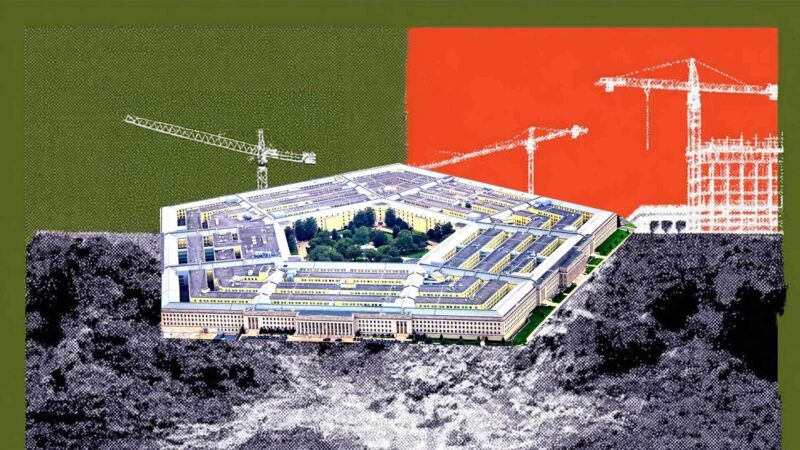3 of the Worst Examples of Military Spending in the 'Big, Beautiful Bill'
It spends $34 billion to subsidize shipbuilding, supply chains, and drone technology.

President Donald Trump signed the One Big Beautiful Bill Act (OBBBA) into law on July 4. The 870-page spending legislation directs $157 billion to the already-bloated military-industrial complex. The following are a few of the most egregious examples of wasteful defense spending in the OBBBA.
1. Over $5 Billion for Shipbuilding
The OBBBA appropriates $5.037 billion, not to procure new naval vessels—although it spends about $20 billion on additions to the fleet—but to subsidize shipbuilding infrastructure. For example, it provides Accelerated Training in Defense Manufacturing (ATDM) $250 million to expand its operations by training people to build and repair submarines. ATDM, which is run by the Institute for Advanced Learning and Research (IALR), a political subdivision of the commonwealth of Virginia, already receives grants from the Navy to provide trainees with free housing and tuition for its 16-week program. Providing the program with even more federal dollars is a subsidy not only for the program's trainees but for Virginia, which operates the IALR in a public-private partnership.
The OBBBA also appropriates $85 million for "United States-made steel plate" and $110 million for a domestic "rolled steel and fabrication facility" for the shipbuilding industrial base. It's curious that American steel manufacturers still require massive taxpayer subsidies to sponsor their production, considering that Trump imposed 25 percent tariffs on imports of foreign steel, which were continued and expanded under former President Joe Biden. Trump hiked steel tariffs from 25 percent to 50 percent and expanded the list of steel derivatives subject to tariffs in June. One would imagine that, after more than seven years of protectionism, the industry would be able to produce steel for overpaid military sales without government support. Instead of subsidizing it yet again, a better approach to support the industry would be to repeal the Jones Act, which has gutted American shipbuilding.
2. 'Supply Chain Resiliency' Receives Nearly $25 Billion
Nearly $25 billion will be spent under the OBBBA to subsidize specific components of the military's supply chain. Another $1 billion is appropriated for unspecified Defense Production Act (DPA) uses. Title III of the DPA authorizes the president "to provide financial incentives to suppliers to meet national defense goals [including] investments and loans," notes the Government Accountability Office. For years, presidents have used the law to subsidize politically favored industries unrelated to national security with little congressional oversight. The Biden administration "invested more than US$870 million via DPA Title III to bolster North American supplies of critical minerals," according to Stillwater Critical Minerals. Trump signed an executive order in March invoking the DPA to "direct the secretary of defense [to buy] critical minerals," explains Reason's Jeff Luse. Trump then designated coal a critical mineral in an April executive order, thereby rendering coal projects eligible for DPA funds.
The OBBBA doubles down on the Defense Department subsidizing entire sectors of the economy by allocating billions of dollars to the Industrial Base Fund (IBF), which authorizes the defense secretary to "support efforts to expand the industrial base" and is used to support DPA Title III projects. The bill appropriates $3.3 billion for IBF "grants and purchase commitments" and $5 billion in IBF funding for the critical minerals industry alone—with an additional $500 million in capital assistance from the Department of Defense Credit Program Account, which provides debt financing for capital investment in property, plants, and equipment with long repayment periods.
The military-industrial complex doesn't need the billions of dollars in taxpayer-provided subsidies. The OBBBA provides them anyway.
3. Wasting $1.15 Billion To Develop Obsolete Aircraft
The F-47 and F/A-XX are planned sixth-generation manned fighter jets that would replace the F-22 Raptor and F/A-18E/F Super Hornet, respectively. The bill directs $400 million to "accelerate production" of the former—while simultaneously spending $361 million to prevent the retirement of the F-22—and $750 million to accelerate the F/A-XX. Meanwhile, the OBBBA appropriates $2.985 billion for the unmanned aerial weapons systems industrial base, $1.935 billion of which is in addition to those funds appropriated for supply chain resiliency. An additional $1.3 billion is allocated to develop "counter-unmanned aerial systems," all of which is from those funds appropriated for supply chain resiliency.
Air Force generals have announced that the U.S. is entering "a new chapter of aerial warfare" where unmanned aerial weapons systems like General Atomics' YFQ-42A and Anduril's YFQ-44A will be the cutting-edge of aerial systems technology. The $4.3 billion allocated to this end proves that this chapter is underway, but over $1 billion is being spent on the last chapter.
The over $34 billion in handouts to the military-industrial complex is a lot, but is only a fraction of the total $157 billion in additional military spending under Trump's OBBBA. Unfortunately for taxpayers, there will undoubtedly be more pork in the Pentagon's $962 billion FY 2026 budget.


Show Comments (23)